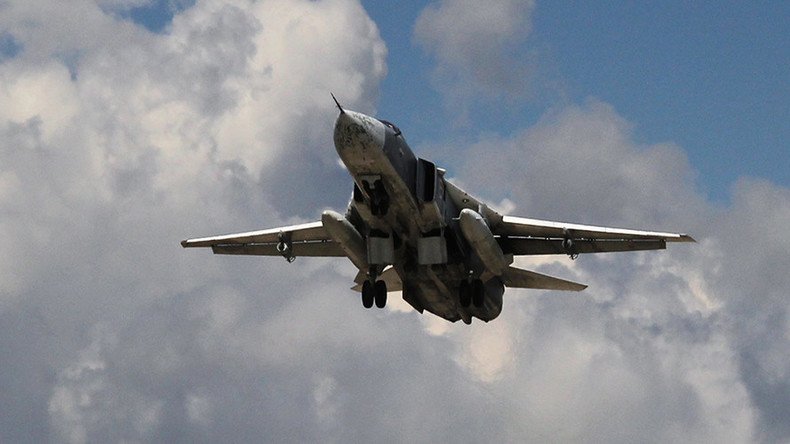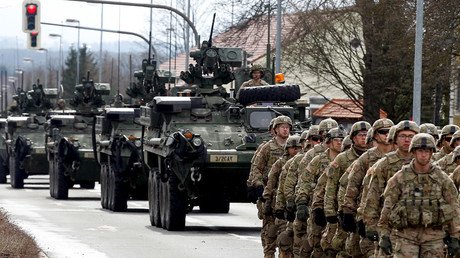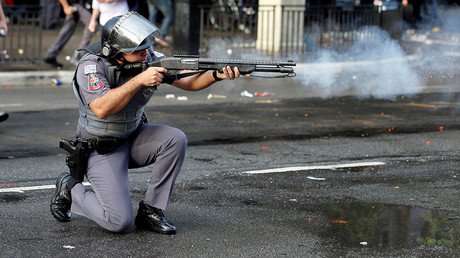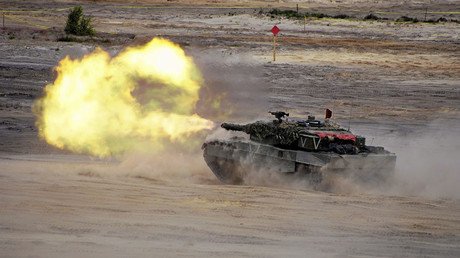With NATO knocking, it’s time for Russian military games in Latin America

With Washington undertaking the greatest military expansion in world history, oblivious to the global ramifications of its sheer arrogance and audacity, the time is ripe for Russia to make a symbolic gesture in America’s backyard.
At the time of this writing, three US B-52 Stratofortress Bombers have just departed from a US airbase in North Dakota, en route to the Baltic States where they will participate in a NATO war game that goes by the cuddly codename ‘Saber Strike’. This two-week gang bang will involve 10,000 troops from 13 NATO countries, as well as several coveted candidates for future membership, like Sweden and Finland.
If you think Russia is comfortable with these annual war dances, you’re probably watching too much Western television.
But this reckless provocation on Russia’s doorstep is just a little sampling of the US-led military adventures now happening across Eastern Europe, which are directly responsible for dragging bilateral relations between Moscow and Washington to their worst levels since maybe forever.
Last month, for example, President Putin commented on the US missile defense system that has just gone live in nearby Romania.
“At the moment the interceptor missiles… have a range of 500 kilometers, soon this will go up to 1,000 kilometers, and worse than that, they can be rearmed with 2,400 km-range offensive missiles… and it can be done by simply switching the software, so that even the Romanians themselves won’t know,” Putin told reporters during a two-day visit to Greece.
“We have the capability to respond,” he said, adding that Poland and Romania, thanks to Washington monkeying with the strategic balance controls, will fall “in the crosshairs” of deadly accurate Russian missiles.
But there are other reasons to be very concerned over NATO’s inexplicable power moves that have raised the alarm in Russia.
As US-led NATO continues its mechanized march eastward, it should come as no surprise that they are experiencing more frequent contacts with the Russian military, yet somehow this baffles Western observers. CNN even ventured to ask the asinine question, in a headline no less: ‘Russian jets keep buzzing U.S. ships and planes. What can the U.S. do?’ Well, stop carrying out military maneuvers so darn close to Russian territory for starters. Moreover, it doesn’t take a military genius to understand that these awkward meetings have the potential to result in disaster.
Consider what happened in April when the USS Donald Cook entered the Baltic Sea and sailed to within 70 nautical miles (130 km; 81 mi) off Kaliningrad, Russia’s strategic exclave nestled between Lithuania and Poland. The naval group was quickly met by a pair of unarmed Russian SU-27s, which performed a series of low flybys of the US destroyer, thus making for nothing worse than very memorable video footage. Nevertheless, this example of 'Russian aggression' triggered the predictable media sh*t storm in the US, with chest-pounding pundits accusing Putin of being “reckless;” Secretary of State John Kerry upped the ante, saying Russia’s in-air antics could have warranted a “shoot down.”
We interrupt this column with a News Break: Not only is the Donald Cook equipped with the most sophisticated radar system in the US Navy, it is armed to the teeth with Aegis-3 missiles as part of the US Ballistic Missile Defense System. To say that this vessel presented a potential threat to Russian military assets in Kaliningrad would be an understatement.
Russian military games in Latin America?
For those who still aren’t convinced that Russia has some serious grounds for concern as the US-led war machine grinds ever closer, let’s put the situation into its proper perspective. Let’s imagine that the geopolitical chessboard were suddenly flipped and it is Russia that is now busy hatching a 28-member military alliance near America’s border, for example, in Latin America (and after Moscow had pledged not to increase the membership of the military bloc following the collapse of the Soviet Union).
But why stop there? Let’s roll the dice and see what Washington’s reaction would be if Russia had just dispatched three TU-160 Blackjack bombers to South America to participate in war games with the likes of Cuba, Venezuela and Brazil, for example, just weeks after Moscow dropped a missile defense system - which could go offensive with the flick of a switch – in, say, Colombia. Yikes! I dare say there’s not a straitjacket in the world that could restrain the writhing neocon convulsions that would break out across the Beltway.
Now for the icing on the crap cake: Imagine that the United States had to swallow these Russian provocations in its Latin American vacation land despite Washington not having carried out an unprovoked attack on another country for over three decades (Yes, I know it’s extremely difficult to imagine, but please play along). But that is exactly the situation that Russia is being forced to contend with. In fact, despite whatever misinformation the mainstream media has pumped into Western brains 24/7 for three decades, Russia has bent over backwards for the last 30 years to help the United States through hell and high water.
Don’t believe me? Who was the first to telephone George W. Bush following the terrorist attacks of 9/11 on New York and Washington? Did the call come from London? Paris? Nah. Would you believe the call came from Moscow, and despite the time difference!? Actually, to be more precise, the call came from Vladimir Putin. But since everybody knows talk is cheap, the Russian leader backed up his words with actual deeds, and honorable deeds at that.
Here is how filmmaker Oliver Stone and historian Peter Kuznick, in their book ‘The Untold History of the United States,’ described Putin’s generous contribution to the US post-9/11: “On September 24, he [Putin] announced a five-point plan to support the U.S. war or terrorism. Not only would he share intelligence and open Russian airspace to the United States… but he would acquiesce in and even facilitate the stationing of troops in the Middle East.”
In the next paragraph, Stone and Kuznick explained how the US politely returned the favor: “Bush repaid Putin’s largesse by breaking his father’s promise to Gorbachev and expanding NATO ever closer to Russia’s borders, effectively encircling Russia with U.S. and NATO military bases… This second wave of expansion began in late 2002 and concluded with the admission of Bulgaria, Romania, Slovakia, Slovenia, Lithuania, Latvia, and Estonia in March 2004.”
Although it is the US and the 28 members of NATO that are amassing on Russia’s border, hosting massive war games and saber rattling, it is Russia that is being typecast as a “resurgent” aggressor hell-bent on restoring the exaggerated glory of empire.
So what is stirring up Eastern European hearts and minds into believing that Russia poses some sort of existential threat to their good times? Nothing more harmless than the hollow sound of propaganda and the tinny clang of money.
Eastern Europe falls for the propaganda
As a journalist, watching NATO’s inexorable advance smack up to Russia’s front door, I am inclined to ask what is the more disturbing scenario: The West’s relentless anti-Russia campaign that prepares the ground for the military encroachment, or the gullibility of the people who place their faith in the steaming pile of horse manure that is released each evening from their television sets.
This is no small consideration since propaganda is the natural lubricant of armies on the march; without the devilish distortion of truth entire Western divisions would soon grind to a halt.
Thus, in an effort to indoctrinate their audiences to the bogus idea of ‘Russian aggression,’ Western media hacks have in their arsenal two historical events that they have sanitized for public consumption. The first is the Russian-Georgian conflict of 2008, a five-day event that began on August 7 when Georgian forces opened a crack-of-dawn military assault on Tskhinval, the capital of South Ossetia.
Although you would never have guessed it from Western reports at the time, the brazen attack killed a dozen Russian peacekeepers and hundreds of civilians. Yet the Western media - which practically covered the conflict from former Georgian President Mikhail Saakashvili’s office - portrayed Russia as the aggressor and Georgia the hapless victim throughout the entire ordeal.
Yes, Russia forces wasted little time rolling into Georgia proper after they took the initial hit, taking over a handful of towns, but what would any other country have done under similar circumstances? In any case, Russia completed its withdrawal of troops from Georgia proper by October 8, two months after the attack began. However, to this day the Western media still drags up this event as some kind of proof-perfect of Russia’s bad intentions.
And yet… An independent investigation, commissioned by the European Union, came to the conclusion – a little late, but hey, beggars can't be choosers - that Georgia was responsible for triggering the hostilities.
“In the Mission's view, it was Georgia which triggered off the war when it attacked Tskhinvali (in South Ossetia) with heavy artillery on the night of 7 to 8 August 2008,” announced Swiss diplomat Heidi Tagliavini, who led the investigation.
“None of the explanations given by the Georgian authorities in order to provide some form of legal justification for the attack lend it a valid explanation.”
None.
Then there was Russia’s “seizure” of Crimea in 2014 around the time that Ukraine was being consumed by internal strife and fascist thugs, much of it agitated by Western interests on the ground in Kiev. But how is it that today the people of Crimea seem satisfied with their new status as citizens of the Russian Federation? It makes no sense! What about all of those tanks and soldiers and fighter jets – the military hardware that is essential to any ‘seizure’ worthy of the name?
Even Forbes begrudgingly admitted, one year after Russia’s “seizure” of Crimea, that “poll after poll shows that the locals there — be they Ukrainians, ethnic Russians or Tatars are mostly all in agreement: life with Russia is better than life with Ukraine.”
Perhaps if the Western media would finally get the story straight, less people would be confused about the situation surrounding Crimea. See, there never was a “seizure” of Crimea by Russian forces. In reality, on March 16, 2014, the people of Crimea – and regardless of their ethnic backgrounds - voted nearly unanimously in a democratic referendum to join the Russian Federation.
No tanks, no Russian soldiers, not a drop of precious blood.
So, as we can clearly see, NATO’s belligerent actions on Russia’s border are absolutely groundless and based on nothing more than hype and hysteria. But that certainly doesn’t make them any less dangerous. Unfortunately, it seems the only way the people of the Western world will wake up and understand how incredibly clueless they have been about Russia over the last 30 years is when they actually experience the fear and loathing that accompanies the sight of a foreign army playing military games in their own backyard.
The statements, views and opinions expressed in this column are solely those of the author and do not necessarily represent those of RT.
















